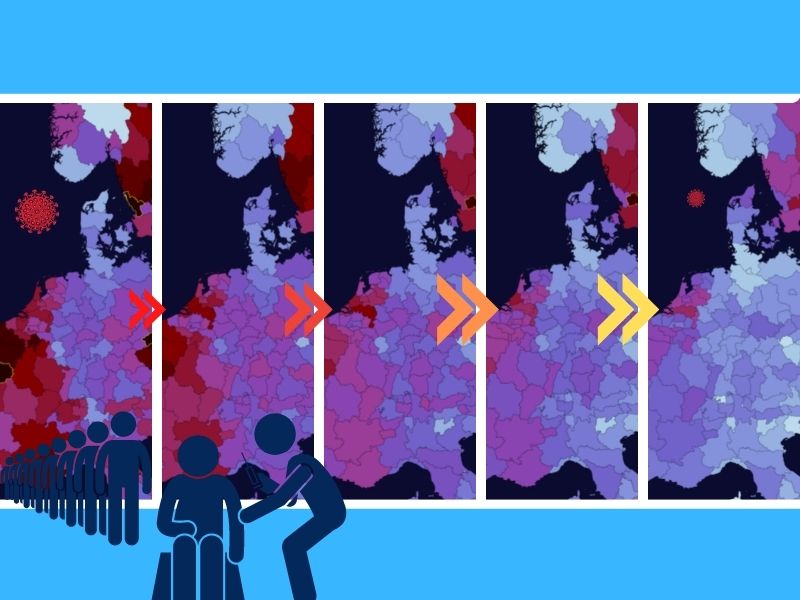
It looks like it will be a matter of a few weeks before the pandemic phase of the corona crisis is behind us and the old normal is back. Across Europe, infection rates are steadily declining and things are starting to calm down in hospitals. Tens of millions of Europeans are now immune to the microscopic scourge that has held the entire world in its grip for over 15 months.
Meanwhile, the effects are more than visible on the charts. For months, the question was ‘when’ the vaccines would start working. By now this question can be answered: in May. How sharply are the numbers of new corona diagnoses plummeting? That becomes very clear very quickly when you compare the chart from May 14 to May 20 with that of a week earlier. The difference with two weeks ago, in the chart below, is altogether colossal. Red colors are a rarity nowadays.
The final phase?
This drop seems to be the result of the vaccination campaigns. How can we be sure of this? European countries have been easing up on restrictions en masse. Where last year around this time, the number of infections needed to be brought down by imposing heavy restrictions until June, this no longer appears to be necessary.
In fact, the locks are being lifted at quite a pace in most countries. Lockdowns no longer seem necessary at the moment because the R value can no longer exceed 1. That is due to the millions of people who have been vaccinated. Last week, the ban on hugging was even lifted in Britain. Something the rest of the continent can also look forward to over the coming months. The ‘old normal’ is gradually phasing back in. Even the festival summer of 2021 is looking like it might stand a chance. Especially for those events scheduled in August and September.
At the beginning of 2021, it didn’t look like this at all here. Not even amongst the British and Portuguese, who are currently among the most Covid-free areas of Europe. In early January, here too, hospitals were still jam-packed with tens of thousands of diagnoses each day and a population that once more faced daunting restrictions on freedom. The heatmap shows how the overall picture is completely different at the end of May. Even Sweden and the Netherlands are crawling out of the danger zone as the number of injections increases by millions every day.
The jab tipping point
With more than 40 jabs per 100 inhabitants, the coronavirus in its current form already seems to have the greatest difficulty in spreading itself around with an R value above 1. Even the dreaded Indian variant, which is causing a small outbreak in the northeast of England, seems to be targeting mainly the unvaccinated or partially vaccinated segment of the population. It is to be expected that a corona infection may become almost a rarity in the upcoming summer.
This is almost already the case on the Faroe Islands. The archipelago recorded only 1 new corona diagnosis this past week. Is where new infections are rare only limited to sparsely populated areas on the edges of Europe? No. Also in the south of England, Portugal and in densely populated Malta, virus prevalence has been driven down to almost microscopic amounts.
Still, the signal that the pandemic fire-fighting is over is not yet in sight everywhere. In Lithuania, Sweden and the Netherlands, although the decline has begun, the figures are still on the high side.
These are the 25 continents that registered the most new patients per 100,000 heads between May 14 and May 20. Note that these numbers are also significantly lower than those for March and April.

Zooming in on the Netherlands
The Netherlands is following the European trend of showing a steady decline. But it is lagging a few weeks behind the rest. Because here – just as in Sweden – the number of infections in the past weeks has been rather substantial, it will take more time for the figures to drop significantly. Yet even here, the difference in the pressure on the ICUs is already noticeable. Moreover, there are also huge regional differences within the Netherlands.
Just as was the case during the first wave, the north of the country seems to be the first to crawl out of the pandemic. Even Groningen and Drenthe are no longer showing up in the front of the continental top 25. We are also bound to emerge from the corona crisis over the next few weeks. This just requires a tad more patience than in, say, Portugal, Poland and Spain. The R value is also here well below 1 now. Very strange things indeed would have to happen for this to change in the near future.
Very soon, the very last instalment of Corona in Europe will probably be published. The reason? A weekly column about a situation that barely changes anymore is not very worthwhile. To end this week’s story on an optimistic note, without any enviable maps from across the border, here are two sliding maps of the Netherlands in which the corona figures of the past seven days have been placed next to those of two and four weeks ago. A world of difference! Who would have ever dared to predict that at the beginning of this year?


